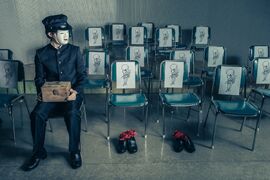mNo edit summary Tag: Visual edit |
mNo edit summary Tag: Visual edit |
||
| Line 8: | Line 8: | ||
* shironuri |
* shironuri |
||
| + | * polka dot |
||
| − | * polkadots |
||
| ⚫ | |||
* uniforms |
* uniforms |
||
| + | * youth in war |
||
| ⚫ | |||
* occult symbolism |
* occult symbolism |
||
* shinto shrines |
* shinto shrines |
||
| + | * noh masks |
||
| ⚫ | |||
| ⚫ | |||
* bunka dolls |
* bunka dolls |
||
| Line 49: | Line 51: | ||
File:Angura art with bunka dolls.jpg |
File:Angura art with bunka dolls.jpg |
||
File:Bunka dolls.jpg|bunka dolls |
File:Bunka dolls.jpg|bunka dolls |
||
| + | File:Angura photography.jpg |
||
</gallery><gallery> |
</gallery><gallery> |
||
Revision as of 20:31, 10 May 2022
| This page needs work. Please help us by expanding it. If you aren't sure how to help, check the article guide Format and Content |
Angura Kei (アングラ系) is a dark Japanese fashion that is often associated with the Eroguro Kei subgenre of Visual Kei. The term is derived from the Japanese pronunciation of ''underground'', which refers to its origins in underground theater.
History
From everything that influences angura kei, the strongest influence is underground theater. Before it has become a style, it was mostly worn by actors in plays during 60-70s.
Visuals
- shironuri
- polka dot
- haori
- uniforms
- youth in war
- rising sun flag
- occult symbolism
- shinto shrines
- noh masks
- bunka dolls
Fashion
The clothes tend to be heavily influenced by traditional Japanese elements as well as the Showa era (1926-1989) but with a Goth spin to it. The make-up usually consists of shironuri, and is dark and heavy. While kimono are the most common used by visual kei artist, the style also often features modified japanese school uniforms. Motifs and accessories are themed around post-war Japan and the occult.
Music
- MUCC
- Inugami Circus-dan
- Strawberry Song Orchestra
- Shinjuku Gewalt
- Zombie Lolita
- cali≠gari
- Guruguru Eigakan
Resources
External links to help get a better understanding of this aesthetic.






